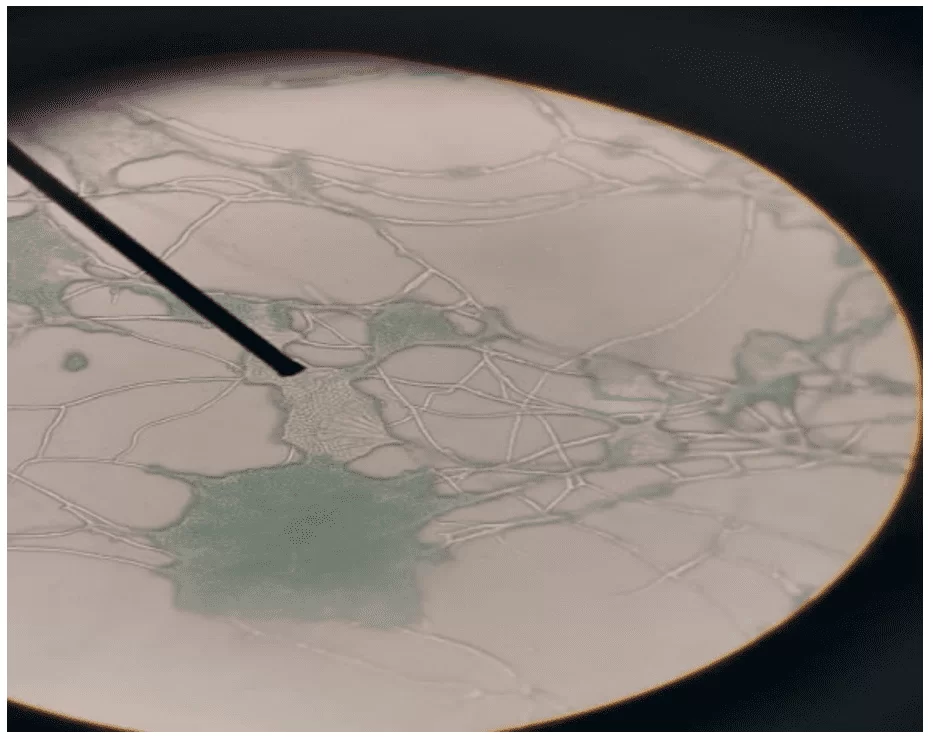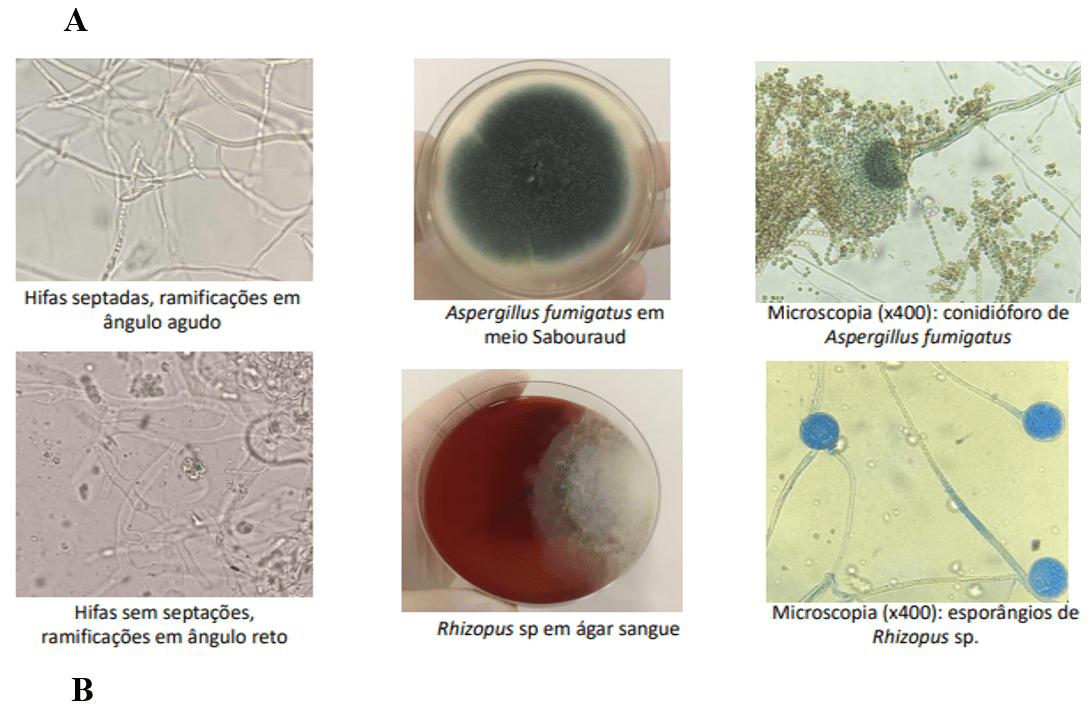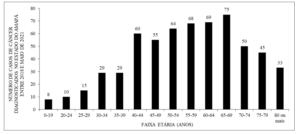REVIEW ARTICLE
MARQUES, Beatriz Cristina Fortunato [1]
MARQUES, Beatriz Cristina Fortunato. Anemophilic Fungal Microbiota Infections in Hospital Environments: A Narrative Review. Revista Científica Multidisciplinar Núcleo do Conhecimento. Year. 08, Ed. 07, Vol. 05, pp. 96-111. July 2023. ISSN: 2448-0959, Access Link: https://www.nucleodoconhecimento.com.br/health/microbiota-infections, DOI: 10.32749/nucleodoconhecimento.com.br/health/microbiota-infections
ABSTRACT
The aim of this article is to discuss the occurrence of anemophilic fungi in hospital environments, elaborating on the characteristics of these pathogens, the primary risks of contamination, and the necessary precautions for protecting non-admitted patients. Regarding the methodological processes, this study is based on a literature review, considering sources found in books, scientific articles, and theses published on academic websites such as Scientific Electronic Library Online (SciELO) and Science Open Research. Inclusion criteria were limited to sources that addressed the occurrence of anemophilic fungi in hospital environments within the predetermined period: from 2010 to 2023. Sources dealing with other topics or published outside the specified timeframe were not considered. According to the results, it was observed that the main fungi found in hospital environments were the genera Aspergillus ssp., Penicillium ssp., Rhizopus ssp., and Mucor ssp., with the primary infection areas being the ICUs and wards. Thus, it was concluded that the occurrence of infections by anemophilic fungi is still very common in hospital environments, requiring increased attention to control and sterilization protocols by healthcare institutions.
Keywords: Public Health, Medical Mycology, Anemophilic Microbiota.
1. INTRODUCTION
Fungi are a group of organisms that can be unicellular or multicellular, eukaryotic, and heterotrophic (unable to produce their own food). It is noteworthy that fungi can be non-chlorophyllous and ubiquitous [2], spreading rapidly in the environment through the air or through other means of transport, such as water, insects, and animals. The term “anemophilic” refers to fungi that have the ability to disperse in the air, as their structures called spores are easily carried by air currents, rapidly spreading throughout the environment (MICHELIN and FONSECA, 2018).
It is also important to highlight that several factors are responsible for facilitating the propagation and growth of fungi in environments, such as temperature, nutrient availability, and humidity. When they enter the hospital environment, the propagative structures (spores) of anemophilic fungi can contaminate humans through inhalation, resulting in infections and allergic reactions. Thus, pathologies such as asthma, sinusitis, and extrinsic allergic alveolitis can lead to a weakened immune system in individuals, exacerbating cases of patients in hospitalization (SALOMÃO, 2017).
Fungi are microorganisms capable of causing opportunistic infections, i.e., infections related to the host’s immune status. When they encounter an individual with low immunity, toxins and metabolites produced by fungi can lead to frequent infectious pathologies, such as urinary infections, eye irritations, otitis, and nail infections (onychomycosis) (CORDEIRO et al., 2021).
Therefore, the hospital environment is constantly exposed to opportunistic pathogens, as fungal infections can be acquired by patients not only through the air but also through contact with hospital visitors and staff. It is worth noting that fungal infections progress rapidly in cases of patients with weakened immune systems, whether due to the use of immunosuppressive medications [3] or underlying conditions such as cancer and Acquired Immunodeficiency Syndrome (AIDS) (VERLI; GONÇALVES, 2019).
It is understood that air quality is widely discussed in the literature as a factor of utmost importance in the occurrence of hospital-acquired infections, especially in situations where pathogens are widely dispersed in the hospital environment. Thus, this study’s primary objective is to discuss the occurrence of anemophilic fungi in hospital environments, elaborating on the characteristics of these pathogens, the primary risks of contamination, and the necessary precautions for protecting patients in situations of hospitalization.
2. METHODOLOGY
This present study is based on a narrative literature review, relying on the research of sources published on academic websites such as Scientific Electronic Library Online (SciELO) and Science Open Research, considering the publication period from 2010 to 2023. Narrative review was utilized to create a discussion aiming for broad analysis and critical interpretations regarding the proposed topic. Thus, the following keywords were used to search for articles: public health, medical mycology, and anemophilic microbiota. Articles addressing the occurrence of anemophilic fungi in hospital environments, whether national or international studies, were considered.
Furthermore, for exclusion criteria, the following were not considered eligible for inclusion in the review: studies not published within the predetermined period, studies addressing the occurrence of fungi in different environments, or studies focusing on other pathogens such as viruses, bacteria, and other microbiota. The main authors cited during the narrative review were Macedo (2019), Verli and Gonçalves (2019), and Abbas et al. (2021).
3. NARRATIVE REVIEW: THE OCCURRENCE OF FUNGAL MICROBIOTA IN HOSPITAL ENVIRONMENTS
It is well-known that hospital environments require extreme care regarding infection control, necessitating constant hygiene and prevention actions by all involved professionals. According to Verli and Gonçalves (2019), research developments have yielded new scientific knowledge regarding methods, techniques, and hygiene protocols capable of assisting in the prevention and treatment of various fungal infections.
Concerning anemophilic fungi, the concern becomes even more justifiable because of their ease of spreading in the environment through their structures (spores), which contributes to making infection control and prevention even more challenging. Considering the frequent occurrence of anemophilic fungi in hospital environments, Borba et al. (2021) discussed cases of infections in neonatal intensive care unit incubators, highlighting the occurrence of the main pathogens from the genera Aspergillus, Candida, Cladosporium, and Nigrospora.
Possible explanations for the mentioned contaminations are related to actions performed in these environments, such as invasive procedures and the need to use broad-spectrum drugs (antimicrobials) that end up providing resistance to fungi. Inadequate hygiene practices by healthcare professionals (asepsis of the area and sterilization of instruments) also contribute to environmental contamination (MACEDO, 2019).
In line with Borba et al. (2021), other studies were conducted to determine the microbiological profile of the main anemophilic fungi found in hospital environments. According to Cordeiro et al. (2021), the wards of a hospital unit in the city of Cabo de Santo Agostinho (PE) were subjected to analysis, where the following filamentous fungi were found: Penicillium ssp., Aspergillus ssp., Fusarium sp., Rhizopus ssp., Cladosporium ssp., Acremo-nium ssp., Tritirachium ssp., Curvularia ssp., and Nigrospora ssp., with the most frequent genera being Penicillium and Aspergillus. Additionally, yeasts and non-sporulating fungi were found.
It is worth noting the various factors that favor the growth and propagation of these pathogens in environments, including relative humidity, temperature, potential hosts, and nutrient availability (NASCIMENTO et al., 2019). Thus, when anemophilic fungi establish themselves in the environment, they spread rapidly through their spores and can be inhaled by the patients present there.
The main manifestations representing infections by these microorganisms are asthma, sinusitis, and even extrinsic allergic alveolitis (ABBAS et al., 2021). Below, an image (Figure 1) is presented that exemplifies one of the most frequent genera of anemophilic fungi in hospital environments.
Figure 1 – Example of a fungus from the genus Penicilium sp. Microscopy: 400x.

Inhalation of fungi from the Penicillium spp. genus can result in a severe infection, progressing to Penicilliosis, a pulmonary pathology that can spread to the body through contamination of the cerebrospinal fluid (CSF), as well as organs such as the kidneys and the endocardium of the heart muscle. It is emphasized that Penicilliosis is considered highly severe since it can affect various vital organs of the body, such as the lungs, heart, and liver. Thus, this pathology proves to be very dangerous in cases of immunocompromised patients, who are vulnerable to septicemia (widespread infection) (ABBAS et al., 2021).
Continuing with the current discussion, another study investigated the occurrence of anemophilic fungi in intensive care units (ICU) of a hospital. According to Calumby et al. (2019), various genera of anemophilic fungi were found, many of them similar to the other studies mentioned in this article. Thus, by analyzing the growth of 114 Colony-Forming Units (CFU), 17 fungal genera were identified in the following proportion: Cladosporium spp. (28.1%), Aspergillus spp. (17.5%), and Penicillium spp. (12.3%).
According to Gonçalves et al. (2018), the genus Penicillium spp. is the most identified among studies that analyze the profile of anemophilic fungal microbiota in hospital environments, which may be related to the ability of this microbiota to adapt to climatic variations, as well as to the immune status of patients. Due to the frequency of these fungal infections in hospital environments, Intensive Care Units (ICUs) stand out as the sectors with the highest contamination rates, resulting in Healthcare-Associated Infections (HAIs) and becoming a public health issue (SILVA, 2017).
4. RESULTS AND DISCUSSION
Based on the analysis of the selected sources and the findings, it was possible to understand the incidence of infections, the sectors with the highest contamination, and the main characteristics of diseases caused by anemophilic fungi.
4.1 HOSPITAL INFECTIONS CAUSED BY FUNGAL MICROBIOTA: INCIDENCE AND CHARACTERISTICS
It is understood that Healthcare-Associated Infections (HAIs), according to the Ministry of Health, are common after a patient’s admission to the hospital and manifest during hospitalization or even after discharge. This terminology is highlighted for infections acquired in relation to hospital admissions or due to hospital procedures (BRAZIL, 2003).
It is important to note that, in Brazil, data regarding HAIs are not widely disclosed or analyzed and end up being archived in the hospitals where they occurred. This reality makes it difficult to access such data and knowledge about the national situation concerning this issue (DOS REIS; CAVALCANTE; DOS SANTOS, 2018).
According to Calumby et al. (2019), the most common fungal microbiota in hospital environments is represented by filamentous fungi from the genera Aspergillus ssp., Cladosporium ssp., and Penicillium ssp. Regarding the most common yeasts, the genera Candida ssp., Cryptococcus ssp., and Trichosporo ssp. stand out. This reality alerts health authorities, as these fungi easily adapt to environments and can spread rapidly through their spore-bearing structures. Based on the analyzed studies, it was possible to create a table (Table 1) that presents the main fungi found in hospital environments, the sectors with the highest contamination rates, and the profile of infected patients.
Table 1 – Main genera of fungi found in hospital environments
| Main genera
Found in hospital environments |
Sectors with the highest incidence of microbial contamination | Principal diseases caused | Profile of infected patients |
| Aspergillus ssp. | Emergency ward, ward, ICUs, neonatal ICU, wards (presence in O2 balloons). | Aspergillosis: opportunistic infection, generally affects the respiratory tract, can progress to the pulmonary form. | Patients with respiratory infections and comorbidities,
immunocompromised, neonates |
| Penicillium ssp | “ICUs, emergency ward” | Penicilliosis: opportunistic infection by the species Penicillium marneffei | HIV-positive patients |
| Candida ssp. | ICUs, neonatal ICU, emergency ward, ward | Candidemia: severe systemic infection | Immunocompromised patients, neonates, |
| Rhizopus ssp. | Ward, emergency ward, ICUs | Mucormycosis: severe opportunistic and invasive infection | Pacientes imunocomprometidos |
| Mucor ssp. | Enfermaria, UTI | Mucormycosis: severe opportunistic and invasive infection | Immunocompromised patients |
| Cladosporium ssp. | Ward, emergency ward, ICU | Allergic disease, which can progress to the invasive form | Immunocompromised patients |
Source: The author (2023).
It is important to highlight Brazilian legislation, which, through Resolution No. 9, dated January 16, 2003, establishes minimum quality standards for indoor air systems and air-conditioned environments, such as hospital environments. According to the mentioned resolution, the Maximum Recommended Value (MRV) is established, which refers to the acceptable index for microbiological contamination in the air-conditioned environment (≤ 750 CFU/m3), with a ratio of I/E ≤ 1.5, where “I” represents the quantity of fungi in the indoor environment and “E” the quantity of fungi in the outdoor environment. These indices represent the acceptable limit value between conditions determining disease or absence thereof for the health of individuals present in the environment.
For the diagnosis of fungal infections, mycological tests should be performed with the collection of biological material (urine, sputum, and nails), analyzed through the direct method. According to the protocol, the diagnosis of fungal infections is determined through blood culture. However, blood culture requires a minimum period to yield results, which can extend up to one week for the complete identification of the microorganism.
Considering fungal infections in hospital environments as public health problems, simple measures can prevent cases of opportunistic fungal infections, such as prioritizing air circulation, sterilizing all instruments used during procedures, frequently washing hands, and performing periodic maintenance of all air conditioning equipment.
ANVISA (2010) regulates that in situations of renovations in hospitals, as well as in any healthcare facility, it is necessary to hermetically isolate the area to prevent the spread of waste, debris, or contamination of the environment by dirt or microorganisms (BRASIL, 2010).
4.2 OPPORTUNISTIC INFECTIONS IN HOSPITAL ENVIRONMENTS AND THE VULNERABILITY OF COVID-19 PATIENTS
The occurrence of infections by the SARS-CoV-2 virus has been widely studied since 2020 when the COVID-19 pandemic spread worldwide. In this context, COVID-19 infections represented a greater risk for hospitalized patients and those with comorbidities, as they had conditions of vulnerability related to low immunity.
Thus, COVID-19 infection together with opportunistic fungal infections represents a major challenge for the nursing team, as well as for all professionals involved and health authorities. Opportunistic infections occur in situations of patient vulnerability, especially in cases of individuals with neoplastic diseases, diabetes, hypertension, and immunocompromised individuals.
Moreover, patients who use corticosteroid drugs, as well as antibiotics and immunosuppressants for an extended period, also have weakened immune systems, making them susceptible to various infections. According to Tavares et al. (2021), patients infected with SARS-CoV-2 presented secondary infections by airborne fungi, with the most common genera being Aspergillus ssp., Rhizopus ssp., and Mucor ssp.
One possible explanation for the occurrence of opportunistic infections in patients affected by COVID-19 is the long-term imbalance of the body’s microbiota, resulting in a disturbance in homeostasis. This risk situation is exacerbated by the use of drugs, leading to liver intoxication. In addition, the antimicrobial therapy administered throughout the patient’s hospitalization has a broad spectrum, resulting in increased resistance of fungi and bacteria to the drugs.
Thus, the National Health Surveillance Agency (ANVISA) established, through Technical Note No. 04/2021, guidelines for identifying fungal infections and prevention measures to control opportunistic infections in patients with COVID-19. Below is a microscopic image of bronchoalveolar lavage from COVID-19 patients with Aspergillosis and Mucormycosis (Figure 2).
Figure 2 – (A): Microscopy of bronchoalveolar lavage with Aspergillosis in a patient with COVID-19. (B): Microscopy of skin biopsy from a COVID-19 patient with Mucormycosis and culture of Rhizopus ssp. on blood agar

According to ANVISA (2021), attention should be paid to opportunistic infections in cases of COVID-19 patients, especially infections caused by fungi of the genus Rhizopus spp. and Mucor spp., which are responsible for Mucormycosis. Thus, constant cleaning of the area is recommended, as well as sterilization of instruments (probes) and disinfection of surfaces, keeping the area free from dirt, dust, or any particles that may carry fungal spores into the hospital environment.
Fungi of the genus Aspergillus spp. are also among the most common in hospital environments and, consequently, are related to co-infection in COVID-19 patients. Pulmonary aspergillosis, when associated with COVID-19, has been identified in cases of worsening respiratory failure, resulting in the death of these patients (TAVARES et al., 2021).
Furthermore, concerning aspergillosis, it is a disease with diverse manifestations, ranging from superficial to systemic levels, and symptoms can vary from a simple allergic reaction to more severe cases such as chronic cavitary disease (Histoplasmosis). In addition to aspergillosis, during the COVID-19 pandemic, recurrent cases of Mucormycosis have been identified, primarily affecting the rhino-orbital region of patients (RIBEIRO et al., 2023).
As treatment options for Mucormycosis, the antifungal Amphotericin B is used, which is an important polyunsaturated organic compound capable of binding to the sterols in the fungal cell membrane. This property results in the formation of pores and, consequently, the leakage of electrolytes contained in the fungal membrane, disrupting the pathogen’s metabolic activities, causing its death. It is also worth noting that male patients are the most affected by Mucormycosis before and after the COVID-19 pandemic, likely due to the recurrence of secondary diseases such as diabetes mellitus, obesity, and hypertension.
5. CONCLUSION
As per the findings, this study successfully achieved its primary objective of discussing the occurrence of airborne fungi in hospital environments, elucidating the characteristics of pathogens, the primary contamination risks, and the necessary precautions to protect patients during hospitalization. It was observed that the main genera found included Aspergillus spp., Penicillium spp., Rhizopus spp., and Mucor spp., with frequent isolation in wards, ICUs, emergency departments, and neonatal ICUs.
A concerning scenario was observed, as the presence of airborne fungi in hospital environments represents a serious global public health issue. Therefore, greater attention from health authorities is required regarding the cleaning, sterilization, and containment protocols adopted in healthcare institutions. Consequently, further studies are needed to explore effective alternatives for controlling infections caused by airborne fungi, considering the variety of genera, species, and potential contamination scenarios.
REFERENCES
ABBAS, Abul K; LICHTMAN, Andrew H.; PILLAI, Shiv. Imunologia Básica – Funções e Distúrbios do Sistema Imunológico. 6ª ed. São Paulo: GEN Guanabara Koogan, 2021, 338 p. ISBN-13: 978-8535282511.
AGÊNCIA NACIONAL DE VIGILÂNCIA SANITÁRIA. Nota Técnica GVIMS/GGTES/ANVISA Nº 04/2021. Orientações para vigilância, identificação, prevenção e controle de infecções fúngicas invasivas em serviços de saúde no contexto da pandemia de COVID-19. Brasília, 14 jun. 2021. Disponível em: https://www.gov.br/anvisa/pt-br/centraisdeconteudo/publicacoes/servicosdesaude/notas-tecnicas/2021/nota-tecnica-04-2021-infeccoes-fungicas-e-covid19.pdf Acesso em: 23 jun. 2023.
BRASIL. Ministério da Saúde. Agência Nacional de Vigilância Sanitária (ANVISA). Resolução da diretoria colegiada – RDC- nº 9, de 16 de janeiro de 2003. Dispõe sobre padrões referenciais de qualidade do ar interior em ambientes climatizados artificialmente de uso público e coletivo. Diário Oficial da União, Brasília: ANVISA, 2003. Disponível em: https://bvsms.saude.gov.br/bvs/saudelegis/anvisa/2003/rdc0009_16_01_2003.html. Acesso em: 23 jun. 2023.
BRASIL. Ministério da Saúde. Agência Nacional de Vigilância Sanitária (ANVISA). Segurança do paciente em serviços de saúde: limpeza e desinfecção de superfícies. Diário Oficial da União, Brasília: ANVISA, 2010. Disponível em: https://portaldeboaspraticas.iff.fiocruz.br/biblioteca/seguranca-do-paciente-em-servicos-de-saude-limpeza-e-desinfeccao-de-superficies/ Acesso em 23 jun. 2023.
BRASIL. Ministério da Saúde. Agência Nacional De Vigilância Sanitária (ANVISA). Microbiologia Clínica para o Controle de Infecção Relacionada à Assistência à Saúde. Módulo 8: Detecção e identificação de fungos de importância médica. Diário Oficial da União, Brasília: ANVISA, 2013. Disponível em: https://www.saude.go.gov.br/images/imagens_migradas/upload/arquivos/2017-02/modulo-8—deteccao-e-identificacao-de-fungos-de-importancia-medica.pdf. Acesso em: 23 jun.2023.
BORBA, Carolina de Farias.; DA SILVA, Mayara Barbara; DE ANDRADE, Melyna Chaves Leite; NEVES, Rejane Pereira; DOS SANTOS, Francisco de Assis Graciano; DA SILVA, Michelangelo Nunes., et al. Prospecção de fungos anemófilos e contaminantes de incubadoras de unidade de terapia neonatal de hospital escola em Pernambuco, Brasil. Revista Brasileira de Desenvolvimento, [S. l.], v. 7, n. 5, pág. 45210–45222, 2021. DOI: 10.34117/bjdv. v7i5.29378. Disponível em: https://ojs.brazilianjournals.com.br/ojs/index.php/BRJD/article/view/29378. Acesso em: 22 jun. 2023.
CALUMBY, Rodrigo José Nunes.; SILVA, Juliana Almerino.; SILVA, Davi Porfirio da; MOREIRA, Rossana Teotonio de Farias.; ARAUJO, Maria Anilda dos Santos.; ALMEIDA.; et al. Isolamento e identificação da microbiota fúngica anemófila em Unidade de Terapia Intensiva/ Isolation and identification of anemophilic fungal microbiota in an Intensive Care Unit. Brazilian Journal of Development, [S. l.], v. 5, n. 10, p. 19708–19722, 2019. DOI: 10.34117/bjdv5n10-186. Disponível em: https://ojs.brazilianjournals.com.br/ojs/index.php/BRJD/article/view/3839. Acesso em: 22 jun. 2023.
CORDEIRO, Priscila Aparecida dos Santos.; SIQUEIRA, Gabriela Karoline Ramos.; DA SILVA, Wendel Medrado Teófilo da.; VIEIRA, Paula Daniele de Souza. Fungos anemófilos associados ao ambiente das enfermarias em unidade hospitalar do Cabo de Santo Agostinho-PE, Brasil. SaBios-Revista de Saúde e Biologia, [S. l.], v. 16, n. 1, p. 1–8, 2021. DOI: 10.54372/sb. 2021.v16.2821. Disponível em: http://68.183.29.147/revista/index.php/sabios/article/view/2821. Acesso em: 22 jun. 2023.
DOS REIS, Amanda Cristina Ferreira.; CAVALCANTE, Samantha Katrine Delcico.; DOS SANTOS, Ingrid Leticia Fernandes. Perfil epidemiológico das infecções hospitalares em uma unidade de terapia intensiva neonatal de um hospital de Cuiabá. 2018, 20f. Trabalho de Conclusão de Curso apresentado ao curso de Bacharelado em Enfermagem ao Centro Universitário de Várzea Grande (UNIVAG), Mato Grosso, Brasil, 2018.
MACEDO, Antonia Jorgiane Rodrigues. Prevalência de infecções microbianas nas unidades de terapia intensiva neonatal de dois hospitais de referência da região norte do Ceará. 2019. 94 f. Dissertação (Mestrado em Ciências da Saúde) -Campus de Sobral, Universidade Federal do Ceará, Sobral, 2019
MICHELIN, Ana Flávia.; FONSECA. Marcia Regina Campos Costa da. Perfil epidemiológico das infecções hospitalares na unidade de terapia intensiva de um hospital terciário. Revista Nursing, v.21, n.236, p. 2037- 2041, 2018. Disponível em: https://pesquisa.bvsalud.org/portal/resource/pt/biblio-907864 Acesso em: 23 jun. 2023.
NASCIMENTO, Jean Phellipe Marques do.; LOPEZ, Ana Maria Queijeiro.; ARAUJO, Mykaella Andrade de.; ARAUJO, Lucas Anhezini.; FILHO, Euripedes Alves da Silva. Airborne Fungi in Indoor Hospital Environments. International Journal of Current Microbiology and Applied Sciences, v. 8, n. 1, p. 2749-2772, 2019. Disponível em: https://www.ijcmas.com/812019/Jean%20Phellipe%20Marques%20do%20Nascimento,%20et%20al.pdf Acesso em:23 jun. 2023
PEREIRA, Jessica Guimarães.; ZAN, Renato André.; JARDIN, Cacilda de Figueiredo.; MENEGUETTI, Dionatas Ulises de Oliveira. Análise de fungos anemófilos em hospital da cidade de Ariquemes, Rondônia, Amazônia Ocidental, Brasil. Revista de Epidemiologia e Controle de Infecção, v. 4, n. 1, p. 18-22, 2014. Disponível em: https://online.unisc.br/seer/index.php/epidemiologia/article/view/4187. Acesso em: 23 jun. 2023
RIBEIRO, Ana Beatriz Oliveira Freire.; MELO, Maria Eduarda Alves de; RIBEIRO, Mariana Oliveira Freire.; CARDOSO, Alessandra Marques. Interface entre mucormicose e COVID-19. Revista Brasileira Militar de Ciências, [S. l.], v. 9, n. 23, 2023. DOI: 10.36414/rbmc. v9i23.150. Disponível em: https://rbmc.emnuvens.com.br/rbmc/article/view/150. Acesso em: 23 jun. 2023.
SALOMÃO, Reinaldo. Infectologia: Bases clínicas e tratamento. 1ª ed. São Paulo: GEN Guanabara Koogan, 2017, 644p. ISBN: 978-8527731805.
SILVA, Lurdeti Bastos da. Monitoramento da microbiota fúngica anemófila em unidade de terapia intensiva. Revista Saúde e biologia, v. 11, n. 3, p. 27–34, 2017. Disponível em: https://revista2.grupointegrado.br/revista/index.php/sabios/article/view/2051. Acesso em: 23 jun. 2023
TAVARES, Ramiro Moreira.; LEITE, Cicero Emanoel Alves.; TAVARES, Ravel Moreira.; OLIVEIRA, Patrícia Lopes.; QUENTAL, Ocilma Barros de. Aspergilose e mucormicose – micoses sistêmicas de importância em COVID-19: Artigo de revisão. Research, Society and Development, v. 10, n. 7, p. e59410717101, 2021. DOI: 10.33448/rsd-v10i7.17101. Disponível em: https://rsdjournal.org/index.php/rsd/article/view/17101. Acesso em: 23 jun. 2023.
VERLI, Marcio Vinicius Abreu.; GONÇALVES, Luis Carlos de Oliveira. Uma visão ampla das infecções hospitalares. Revista Panorâmica online– Dossiê: Educação Física Escolar, v. 27 n. 2, 2019. Disponível em: https://periodicoscientificos.ufmt.br/revistapanoramica/index.php/revistapanoramica/article/view/865 Acesso em: 23 jun. 2023.
APPENDIX – FOOTNOTE
2. Ubiquitous, organisms present everywhere in the environment.
3. Drugs used for the treatment of autoimmune diseases or to prevent organ rejection in transplant patients.
4. Laboratory test that detects bacteria in the blood using specific culture media.
5. A state of balance in which the body can perform all its functions and chemical reactions.
[1] Specialization in progress in the field of Clinical Analysis, Specialist in Public Health, Graduation in Biomedicine. ORCID: https://orcid.org/0009-0008-6447-0024. Lattes Curriculum: http://lattes.cnpq.br/6424088561519108.
Submitted: June 23, 2023.
Approved: July 19, 2023.















